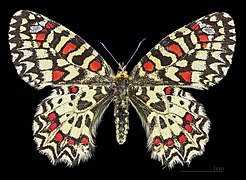|
Zerynthia rumina
Zerynthia rumina, the Spanish festoon, is a butterfly belonging to the family Papilionidae. It is a widespread species in Iberia and frequents most habitats. DistributionNorth Africa, the Iberian Peninsula and southern France. DescriptionZerynthia rumina is an extremely striking species. In south east France it can be confused with the southern festoon (Zerynthia polyxena). The two can be told apart by the presence of blue on the hindwing of the southern festoon. The Spanish festoon also has extensive red on the forewings. Description in SeitzT. rumina L. (10 a). At once distinguished from polyxena by the totally different underside of the hindwing, which bears whitish yellow spots at the base. Nearly all the costal spots of the forewing are marked with red. The 3 or 4 black parallel cell-bars of polyxena are in rumina enlarged, being separated by thin yellow bands. In Spain and Portugal, also in Morocco and Algiers, but occurring here only in the coast districts in a slightly different form (10 a). — In ab. canteneri Stgr. (10 a), which occurs singly among ordinary rumina in South Spain and Morocco, the ground-colour is dark yellow, almost orange, the transparent apical spot being therefore very prominent, appearing bright silvery. — ab. honnorati Boisd. (10a). is the name of a form in which the red colour is very much extended, the spots of the hindwing merging together to an often broad purple-band. This form occurs in South France, especially in the neighbourhood of Digne, but only very sparingly, the ordinary form of South France being medesicaste Ill. (10 a), in which the black spots of the forewing are mostly centred with red, while the red spots of the hindwing remain separate. — Also of these forms melanotic aberrations have been found, that of the Spanish rumina being named tristis Oberth., while the black form of the French medesicaste is hartmanni Stdfss. — In ab. paucipunctata Neub. all the red spots of the forewing are reduced, whUe in ab. alicea Neub. the third (reduced) black costal spot has no red centre. — Transitions from typical rumina to medesicaste are named ab. castiliana, from Castilia. — Larva yellow, red, or blackish, with short pale stripes and yellowish red tubercles bearing black hairs; earh' summer, on Aristolochia. Pupa grey -brown, variegated with black. — The butterflies are on the wing in spring, in the South already in February, in North Spain late in March; they are found on sunny slopes and in vineyards, settling especially often on Asphodelus. [1]
Flight periodThe flight period is generally in April and May with the possibility of a very small second brood in September.  SynonymyThis species represents an extreme example of oversplitting.
References
External links
|
||||||||||||||||||||||||||||








